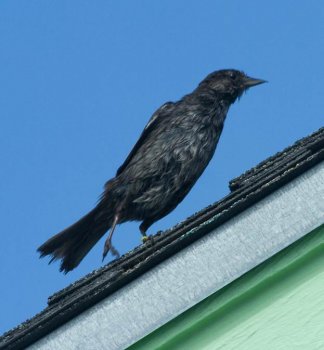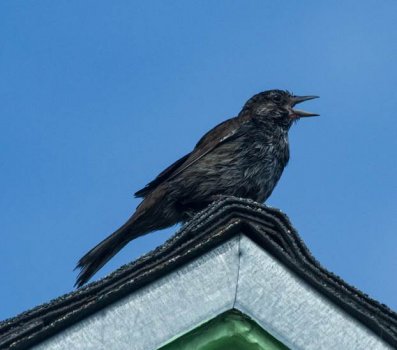The results of the 2014 Homer Christmas Bird Count have been tallied: 67 species (9,483 birds) were counted on the day of the count, and 8 more species were seen during the count week.
Thanks to everyone who participated!
The results of the 2014 Homer Christmas Bird Count have been tallied: 67 species (9,483 birds) were counted on the day of the count, and 8 more species were seen during the count week.
Thanks to everyone who participated!
The final version of the 2014 Kachemak Bay Shorebird Monitoring Project report has been completed by George Matz.
This report contains:
Cranes in Homer: 8-18-14
Nina Faust reports "The colts are fledging and the non-breeding flocks are returning to the area and gathering. Please send reports of flock locations, time, date, number and how many of them were colts. Enjoy them, migration is less than four weeks away. “ Call 235-6262 or reports@cranewatch.org
The flocks are moving around with migrational unrest, and the families are beginning to join the flocks. Nina said the crane numbers are about the same as last year according to her information. She knows of 11 colts for sure that have now fledged.
The expected departure date for the cranes is around September 10-15th. They wait until the pressure and winds are just right then leave in groups, but often some families with late-fledging colts stay a while longer.
Check out these interesting videos.
“Lesser Sandhill Crane Flight Training” http://www.youtube.com/watch?v=7hf8Yzu17o8
“Lesser Sandhill Cranes: A Tale of Lynx Stalking” https://www.youtube.com/watch?v=B09PJsxm3e8&feature=em-share_video_user
In early June, David Hanson, a Texas birder, took some photos from inside Spit Sisters of an odd, black bird. He had been on trips up here before and he knew that this was not a usual sighting out on the spit. He showed the photos to several birders who were quite perplexed as to what it was and thus began our quest to discover just what in the heck this bird was?
Early on it was suggested that it was only a wet, bedraggled Song Sparrow but the bill seemed wrong and also the size. Gary Lyon measured the shingles in the photo and found that the exposed shingle was 6 inches so the bird was accurately measured at 8-9 inches long.

The bird had a yellow band on one leg which we thought meant that it had been a caged bird since wild birds are banded also with a metallic band. At one point we thought that a yellow band meant that it was from Peru but later found out that yellow bands mean Peru only if they’re shorebirds.
The other clues that it had been a caged bird were that the feathers were rumpled and unkempt and the tail was quite bedraggled. And, according to Martin Renner, that the lower mandible was shorter than the upper one.
It was singing so that meant a male no doubt. Unfortunately Dave had been inside the busy, noisy Spit Sisters restaurant when this was happening so he couldn’t hear the song at all.

We contacted Cornell and they had several folks look at the photos and decided that it was probably a Red-winged Blackbird. This based on the physiology and the fact that they are in Alaska. I wanted to say BUT, IT HAD BEEN CAGED so could have come from anywhere, couldn’t it? Could it be a Melodious Blackbird or Scrub Blackbird, however unlikely?
We tried to track down a bona fide Icterid specialist but could not find one. There must be one out there somewhere? And through this time we advertised and promised absolute “unlimited fame” to anyone who would ID this bird with certainty.
Recently we discovered an interesting website called WhatBird where you post a photo plus information and lots of folks look and hopefully respond. Our post got over 480 viewings but few useful responses. They suggested possibly Melodious Blackbird which is from Central America but gave no real evidence. What happens on this site is that your post gets buried deeper and deeper if no one responds, so I wrote some little additions to my post and so we’d get back on Page One for a while. I did my best! It was mind boggling, but maybe comforting, to see how many people had birds they couldn’t identify! (Gee, it wasn’t just us!!)
So here we are, nearly two months after the original sighting. Our conjecture is that it’s a Red-winged Blackbird. But we will always wonder why it had the yellow band, why someone would have had it in a cage, and whatever happened to it?
Maybe “When you have eliminated all which is impossible, then whatever remains, however improbable, must be the truth.” Arthur Conan Doyle, The Case-Book of Sherlock Holmes.
We as birders have an opportunity to help set aside prime habitat for birds by purchasing a Migratory Bird Stamp each year. Fully 98% of this purchase goes directly to buying wetlands, grasslands and other key habitats for our birds, expanding the National Wildlife Refuge System.
I am amazed at the opportunity this gives us if we can just educate birders about what this means and what we, as birders with our huge numbers, can do for setting aside prime habitat. If we all bought a stamp in one year we would raise more than has been purchased in 80 years!!! It is a force!
As we show our support we will be able to include images of other migratory birds on these stamps. Presently waterfowl are depicted. This can become quite the program if we can get the word out, unruffle any feathers of misinformation that has circulated in the past and strive forward to purchase land for our birds into the future.
(from the USFWS Federal Duck Stamp Office)
“At the turn of the century, significant bird protection efforts arose to end the disturbing slaughter of birds. This was effectively the country's first organized movement by individuals we generally know as “birders” today. The initial crisis in the 20th century bird conservation was addressed by the Lacy Act of 1900, the creation of Pelican Island in 1903 as the first Federal refuge in the country, and the Migratory Bird Treaty Act of 1918. These events effectively outlawed forever the indiscriminate killing of birds in this country, along with the use of their feathers for interstate trade.
A second bird-crisis emerged as a result of the over draining of wetlands, the degradation of prairie grasslands through increased mono-crop agriculture, and by cycles of over-harvesting of waterfowl on ever dwindling habitat. Along with the Dust Bowl of the depression years these events culminated in a drastic loss of waterfowl. An important step taken to address this crisis was the creation of the Federal Migratory Bird Stamp in the mid-1930’s, an action which sought to strengthen a National Refuge System in desperate need of support.”
This system once again is in desperate need of support! Birders to the rescue! We started this protection of our Migratory Birds and we need to continue our direct on-the-ground protection by purchasing an annual Migratory Bird Stamp each year. They are available on line for $15. Go to https://store.usps.com/store/browse/subcategory.jsp?categoryId=duck-stamps (A current stamp of the year also gives free entrance into any Wildlife Refuge that charges admission.)
We have a responsibility to continue the job we started…to protect the birds that give us so much joy by setting aside nesting, rearing, wintering and stopover refuges so they are assured open space and we can continue to monitor and enjoy them.
The Kachemak Bay Birders last meeting until August will be Thursday, May 29th at 4:30 pm at Islands and Ocean Visitor Center in the Seminar room. After the meeting there will be a potluck meal and members will share slides. Come and enjoy this last gathering, great meal and always interesting slides! Bring a dish to share and up to 10 slides on a thumb drive if you'd like to show them.
Everyone is welcome and there is no charge. For more information contact Lani Raymond 399-9477 or Lori Paulsrud 299-3724. Cosponsored by the Alaska Maritime National Wildlife Refuge.
The Kachemak Bay Shorebird Festival is almost here!! May 8th -11th
http://www.homeralaska.org/visit-homer/events-homer/kachemak-bay-shorebird-festival
AND, there's also going to be a Birding Festival in Kenai May 15th -18th
The final CBC report from Dave Erikson is finished . We got 54 species for the day and then an additional 5 species for the Count Week.
What we found: HARLEQUIN DUCK, SURF SCOTER, WHITE-WINGED SCOTER, BLACK SCOTER, LONG-TAILED DUCK, BUFFLEHEAD, COMMON GOLDENEYE, COMMON MERGANSER, RING-NECKED PHEASANT, RED-THROATED LOON, COMMON LOON, HORNED GREBE, RED-NECKED GREBE, PELAGIC CORMORANT, BALD EAGLE, NORTHERN GOSHAWK, ROCK SANDPIPER, MEW GULL, HERRING GULL, GLAUCOUS-WINGED GULL, COMMON MURRE, murrelet sp., ROCK PIGEON, DOWNY WOODPECKER, HAIRY WOODPECKER, NORTHERN SHRIKE, GRAY JAY, STELLER’S JAY, BLACK-BILLED MAGPIE, NORTHWESTERN CROW, COMMON RAVEN, BLACK-CAPPED CHICKADEE, BOREAL CHICKADEE, RED-BREASTED NUTHATCH, BROWN CREEPER, PACIFIC WREN, GOLDEN-CROWNED KINGLET, RUBY-CROWNED KINGLET, AMERICAN ROBIN, VARIED THRUSH, BOHEMIAN WAXWING, CEDAR WAXWING, AMERICAN TREE SPARROW, FOX SPARROW, SONG SPARROW, WHITE-CROWNED SPARROW, GOLDEN-CROWNED SPARROW, DARK-EYED JUNCO, SNOW BUNTING, GRAY-CROWNED ROSY-FINCH, PINE GROSBEAK, PINE SISKIN, RUSTIC BUNTING, MOURNING DOVE.
Count Week species : GREAT HORNED OWL, NORTHERN HARRIER, HARLAN’S HAWK, MARBLED MURRELET, PIGEON GUILLEMOT.
The largest numbers were BOHEMIAN WAXWINGS (1027), NORTHWESTERN CROW (372), and BLACK SCOTER (360). A total of 3578 individual birds were counted.